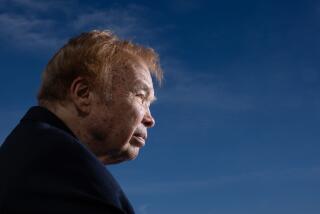Dennis Puleston; Activist Led Battle to Ban DDT
- Share via
He loved birds. He liked simply watching them, or painting vivid watercolors of them. Almost single-handedly, he saved the osprey, the bald eagle and the peregrine falcon.
Dennis Puleston, a boat builder, adventurer, author and artist instrumental in winning a ban on the pesticide dichloro-diphenyltrichlorethane (DDT) throughout the U.S. and in many foreign countries, died June 8 at his home in Brookhaven, N.Y. He was 95.
Puleston, the dedicated amateur ornithologist, became an environmentalist in 1966 after observing a marked decline in the hatchings of the osprey (also called a fish-hawk) on Long Island where he lived.
Spraying of DDT to abate mosquitoes, he found, so weakened the shells of the osprey eggs that the chicks inside died. Alarmed, he joined friends in suing the Suffolk County Mosquito Control Commission to halt the spraying.
Puleston’s watercolor artistry in seven canvases depicting the food chain from plankton to blue-claw crabs to large birds, including the osprey, convinced a local judge that DDT was harming the ecology and must be banned.
Puleston built on that success by forming the Environmental Defense Fund in 1967 and serving as its chairman until 1972. Now called Environmental Defense, the group has some 300,000 members and enlists science, law and political activists to fight environmental pollution.
By 1972, DDT had been banned across the U.S., and foreign countries were beginning to follow suit.
That was only one of Puleston’s retirement-era projects. Another was offering witty and informative lectures to tourists willing to follow him on adventure cruises up the Amazon or off to Antarctica. He led some 200 of the cruises, including 35 to the southernmost icy continent.
He particularly loved Antarctica, he once said, because “it has not been altered by man and is still teeming with wildlife.”
Born in the British fishing village of Leigh-on-Sea, Puleston grew up intrigued with boats and birds and the rest of nature, and certainly with adventure.
He studied naval architecture and biology at London University and then in 1931 set to sea with a friend and $120 in a 29-foot sailing yawl for a six-year odyssey. They crossed the Atlantic, skittered along the East Coast, stopping to teach sailing at Rye, N.Y., and operated a coconut plantation at Tortola in the British Virgin Islands. Then on through the Caribbean and across the South Pacific.
“Remind me to tell you about the local virgins in Samoa,” the white-haired, white-bearded environmentalist told an interviewer in 1993.
“These beautiful Polynesian maidens with the undulating arms kept serving that kava. . . . It’s not really intoxicating, but from the waist on down, you’re just paralyzed. . . . Unfortunately, the kava had done its work, and the next morning the local virgins were still the local virgins.”
The intrepid sailors reached China in 1937, at the outset of the Sino-Japanese War. Puleston escaped to London on the Trans-Siberian Railway and two years later published an account of the trip, “Blue River Vagabond.”
Settling in New York where he married Betty Wellington, Puleston became an American citizen in 1942 and started working with naval architects to design the Duck-like DUKW, the amphibious landing craft used in the Normandy landing and nicknamed the Duck. He spent the war years training American and British forces on using the craft, running his schools from India to Okinawa. He was wounded by a Japanese shell splinter that struck his spine when he was teaching British troops in Burma.
President Harry S. Truman awarded Puleston the Medal of Freedom in 1948 for his work on the Duck.
That same year, Puleston joined the Brookhaven National Laboratory in Upton, N.Y., where he worked until his retirement in 1970.
In 1992, he published another book, “A Nature Journal: A Naturalist’s Year on Long Island,” illustrated by 155 of his watercolors of birds, animals and plants.
Puleston is survived by his wife, Betty; a son, Peter, of New Brunswick, Canada; and two daughters, Jennifer Clement of Brookhaven, N.Y., and Sally McIntosh of New Brunswick.
More to Read
Sign up for The Wild
We’ll help you find the best places to hike, bike and run, as well as the perfect silent spots for meditation and yoga.
You may occasionally receive promotional content from the Los Angeles Times.





